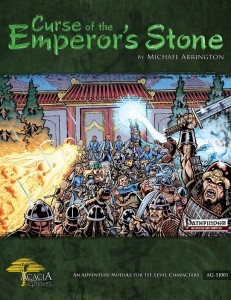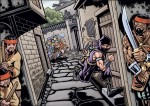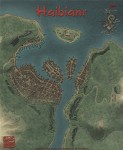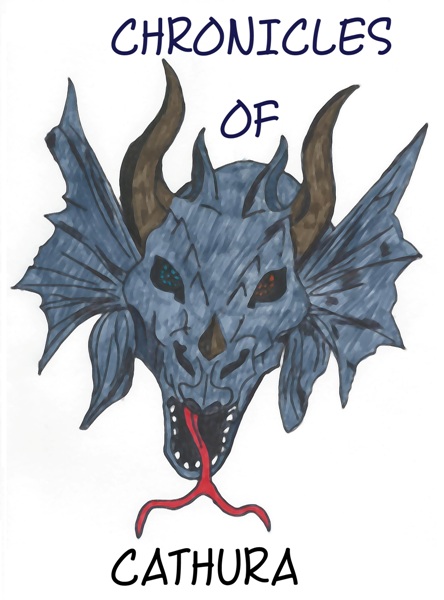Curse of the Emperor’s Stone
Curse of the Emperor’s Stone is an adventure module for the Pathfinder Roleplaying Game published by Acacia Games.
By Michael Arrington

Welcome to the first Designer’s Diary, a regular column where designers are given the opportunity to take readers on an in-depth ride through the design and development process of their system, setting, or product.
Designer’s Description
Curse of the Emperor’s Stone is a fantasy roleplaying adventure for beginning characters. It is designed for use with Paizo Publishing LLC’s Pathfinder Roleplaying Game but can be easily adapted for use with other d20 system fantasy games and, with a little work, other fantasy roleplaying games. The adventure is designed to introduce characters to the lands of Dazhou, a continent roughly analogous to our world’s Asia, either as a one-shot adventure or as an opening to a larger campaign set in Dazhou – which will be further detailed in future adventures and campaign setting books from Acacia Games.
In the opening scenes of the adventure, the characters travel to the cosmopolitan port city of Haibianr as crewmembers aboard a trading ship. Once there, through a series of unfortunate events, they come into possession of the Emperor’s Stone, an ancient artifact that seems to draw trouble to itself – and to its hapless bearer. Over the course of the adventure the characters learn about the Emperor’s Stone and its history, realize they’re probably better off without it, and undertake a quest to dispose of it safely. Of course, other factions also want to get their hands on this powerful artifact. Curse of the Emperor’s Stone is expected to be available for purchase in print and PDF in late May.
Purpose
I had wanted to do something in the roleplaying game space for quite a while. Attending PaizoCon 2009, where Paizo gave a preview of its upcoming Pathfinder Roleplaying Game, galvanized this desire for me. As I thought of potential products for users of that system my mind went straight to adventures: GMs can use them as written or mine them for plot points, encounters, NPCs, and other goodies for their own campaigns.
Adventures are also an excellent way to establish new settings and I felt that Curse would allow me to introduce customers to the setting that I eventually intended to build or, if they weren’t interested in that setting, I could at least provide them with several evenings’ enjoyment before they turn back to their own worlds. To that end, it was important that the adventure serve either as the gateway to my future campaign setting or as something that could be grafted, wholly or in part, into any GM’s setting. I think Curse accomplishes that goal fairly well.
Influences
I have an affinity for our world’s China, something that developed entirely due to random circumstances. My first “real” job required (and paid for) me to spend a year learning to speak, read, and write mandarin Chinese in an immersive environment. During that time I also received an introduction to the people, culture, cuisine, and other aspects of Chinese society. During my early career, I also had the opportunity to work with other folks who had similar training in other Asian languages and cultures, from Japanese and Korean to Cambodian and Laotian. The experience inspired me to explore how these cultures might be mirrored in a fantasy world.
Haibianr, the backdrop city in Curse, is largely inspired by our world’s Hong Kong. It’s the perfect place for an adventure, in any era. Hong Kong is a truly amazing place – an amalgam of East and West that yields an indefinable mystique juxtaposed with crassly pragmatic consumerism. A visitor wanders the streets and looks down dark alleyways and stairways leading below street level and into cramped shops filled with strange goods, only wondering about the sorts of things folks are up to in those places. The events in Curse, I think, are just those sorts of things.
It’s important to note that the lands of Dazhou are simply inspired by our world’s Asia; they are not intended to be a mirror image seen through a fantasy lens. On Earth there are no dwarven strongholds in the Himalaya, no lizardmen in Guangzhou, no serpentfolk ruins in the jungles of Cambodia. The people of Minguo are not Han and Minhua is not Chinese (though this might be the closest parallel, given my linguistic bent).
Research
I have a lot of reading material on Asia and Asian culture, mythology, and language and there’s a lot out there on the Internet as well. I read and get inspired and write down bits of things that appeal to me and that I’d like to explore further. I’m also a very visual person so Google Images is a goldmine for me. I like to just pop in random keyword searches to see what comes back; anything interesting goes into my “inspiration” folder, which is quite extensive at this point.

Art Direction
I had intended to include mostly realistic, perhaps slightly dark, illustrations in Curse; but the adventure’s art direction took an unexpected turn thanks to a couple of artist friends-of-friends. Portland, where Acacia Games is based, is somewhat known for its comic scene (Dark Horse is in nearby Milwaukie) and there are more than a few local comic artists. The freelance illustrators I commissioned to do the art for Curse are both drawn from this group, by way of reference from friends.

One of these, Owen Hunter, took on the NPC illustrations. His initial drafts were a little more toward the comic end of the art spectrum than I had initially desired or anticipated… but I liked them so I had him run with them. Later, I was introduced to James Sinclair, a 14-year veteran of the comic industry (including Dark Horse and DC). I showed James my sketches for a few illustrations and he turned over some thumbnails showing how he planned to execute them. They were, frankly, pretty darned awesome and I was sold.
The art didn’t turn out quite as I had envisioned when I first put pen to paper but I am very excited by what James and Owen have done for Curse. I may go with a more realistic style in future products… or maybe not!
Gaming Experience
Curse, and likely some of the adventures that will follow it, is inspired to some degree by pulp adventure stories and movies. The intent was to deliver several fast-paced scenes punctuated by periods of relative quiet. It has a strange artifact MacGuffin, ominous organizations to oppose the protagonists, rickshaw chases through crowded streets, mysterious benefactors, and an epic battle to top it off. I think it’d make a pretty good short film… and that’s how I think a good fantasy roleplaying adventure should play out.
Comparison
That is a good question; and I hope that reviewers of Curse will let me know the answer gently! I think that it compares favorably against many third-party publisher adventures in terms of quality of the story, writing, and artwork. To my mind, Paizo sets the standard for quality in the fantasy roleplaying space. My lofty ambition is to release only products that I believe the crew in Redmond would consider publishing under their imprint. I hope I’ve achieved that goal with Curse.
Development Process
For my home groups I have run published scenarios, created detailed adventures of my own, and run games on the fly from a handful of notes. Designing materials for other GMs to use, however, is a different sort of animal. You have to provide enough flavor and crunch to play out the plot you’ve devised; but you also have to provide enough details and advice to help the GM when the players suddenly, but inevitably, take the adventure “off the rails”. So, you’re not just publishing an adventure, you’re designing in detail a good deal of the stuff behind the curtains – even if you only share a portion of it in the product itself.
Since I was starting from scratch with a new setting this required a highly iterative design process. The basic plotline for Curse was in place relatively quickly: the PCs travel to an exotic city and a dangerous item falls into their hands, requiring them to undertake a quest to dispose of it. Of course, that story is set in a city, which needed fleshing out; and on a continent, which provided important background; and on a planet, which gave everything a context. Designing an entire world is a difficult undertaking, and time-consuming – unless you happen to be a deity of some sort, in which case I understand the process can be shortened to around a week, give or take.

I wanted the city in which Curse takes place to be something like our world’s Hong Kong, bustling and full of mystery and intrigue. Haibianr, which translates approximately to “Seaside”, is located along Dazhou’s eastern coast and serves as the gateway between that continent and lands east, where most of Shijie’s (the name of the planet, see what I mean about iterative?) European-analog nations lay. After roughing out the adventure’s plotline I doodled a map of the city and then put some thought into its workings and organizations – and its interactions with the rest of Dazhou.
That step made me think about the rest of the continent. I very much wanted a “points of light” setting, where a good deal of the world is frontier, though it has not always been so. As with Haibianr, I started with a map and then spent some time thinking about details: what settlements exist, how does trade flow, what are the cultures like? As I worked through these ideas, cherry-picking the things I wanted to include, I had to begin working back into the past to come up with a story for why things stand as they do. This got me thinking about origin stories (true ones, not mythological) and, eventually, the planet as a whole, its solar system, and the overall cosmology of the universe in which Dazhou resides.
A lot of this work came back to enrich Curse in one way or another, even if only in mention. For instance, the origin and nature of the Emperor’s Stone itself was now easy to plot out. I wanted it to have been around for a long time and to have been a part of the long history of Minguo. You can read a little bit of that history in the two-page PDF preview of Curse that accompanies this article and judge for yourself how I did.
Click the thumbnail below to view the preview of Curse of the Emperor’s Stone.




